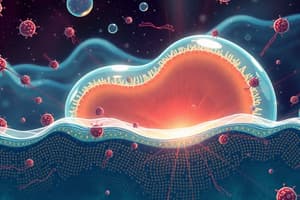Podcast
Questions and Answers
Innate immunity refers to defenses that are present at birth.
Innate immunity refers to defenses that are present at birth.
- Innate immunity refers to defenses that are only present in certain individuals.
- Innate immunity refers to defenses that are developed during childhood.
- Innate immunity refers to defenses that are only present in adults.
- Innate immunity refers to defenses that are acquired over time. (correct)
Which of the following is NOT an example of external physical and chemical barriers of innate immunity?
Which of the following is NOT an example of external physical and chemical barriers of innate immunity?
- Phagocytes (correct)
- Mucous membranes
- Antimicrobial substances
- Skin
Which of the following is NOT an example of internal defenses of innate immunity?
Which of the following is NOT an example of internal defenses of innate immunity?
- Phagocytes
- Natural killer cells
- Adaptive immune response (correct)
- Antimicrobial substances
Which of the following is a physical barrier that serves as the first line of defense against pathogens?
Which of the following is a physical barrier that serves as the first line of defense against pathogens?
Which of the following is a chemical barrier that serves as the first line of defense against pathogens?
Which of the following is a chemical barrier that serves as the first line of defense against pathogens?
Which of the following is NOT a component of the second line of defense against pathogens?
Which of the following is NOT a component of the second line of defense against pathogens?
What is the purpose of inflammation in the body's immune response?
What is the purpose of inflammation in the body's immune response?
What conditions may trigger inflammation in the body?
What conditions may trigger inflammation in the body?
Flashcards are hidden until you start studying
Study Notes
Innate Immunity Overview
- Innate immunity consists of defenses that are present at birth, offering the first line of protection against pathogens.
External Physical and Chemical Barriers
- Skin acts as the primary physical barrier, preventing pathogen entry.
- Mucous membranes also function as a physical barrier by trapping pathogens and debris.
- Chemical barriers include antimicrobial peptides and enzymes, which provide additional protection against pathogens.
- An example of something that is NOT an external barrier would be internal immune responses like phagocytosis.
Internal Defenses
- Internal defenses include mechanisms such as the action of white blood cells, inflammation, and fever.
- An example of something that is NOT an internal defense is a physical barrier like skin.
First Line of Defense
- The skin and mucous membranes are crucial physical barriers, serving as the body’s first line of defense against pathogens.
- Chemical barriers like stomach acid and enzymes in saliva also act as initial defenses to neutralize invading pathogens.
Second Line of Defense
- The second line of defense includes internal mechanisms like inflammation, fever, and the activity of immune cells.
- Components NOT included in the second line of defense may involve external barriers and non-specific mechanisms that do not directly act against pathogens.
Purpose of Inflammation
- Inflammation aims to localize and eliminate pathogens, as well as promote healing and tissue repair.
- It increases blood flow to affected areas, allowing immune cells to reach and combat potential threats more effectively.
Conditions Triggering Inflammation
- Inflammation can be triggered by various factors including infection, injury, allergens, and irritants.
- Physical damage or microbial invasion often leads to an inflammatory response to guard against further harm to the body.
Studying That Suits You
Use AI to generate personalized quizzes and flashcards to suit your learning preferences.




